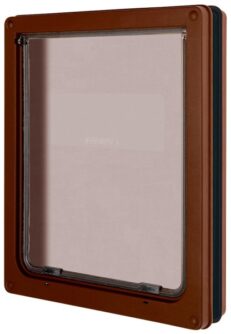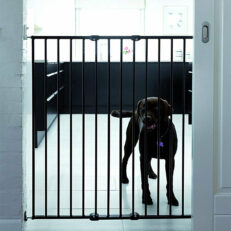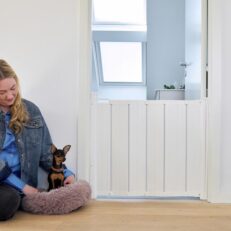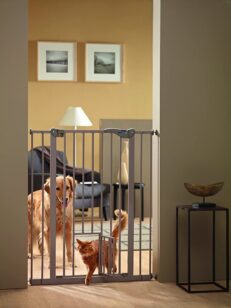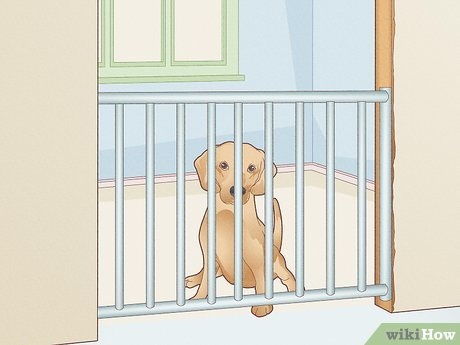
Pet gates are an essential aspect of creating a safe and controlled environment for pets at home. They serve as a protective barrier, preventing pets from accessing potentially hazardous areas like kitchens, where they might encounter dangerous appliances, or staircases that pose a risk of falls. Beyond just safety, pet gates also play a significant role in behavioral training. By establishing clear boundaries within the home, they assist in teaching pets about restricted areas, promoting discipline and good behavior.
For pet owners, the installation of pet gates offers considerable peace of mind. Knowing that their beloved pets are confined to safe areas within the home can alleviate concerns about their well-being, especially when the owners are not around to supervise. This sense of security is invaluable, as it ensures the pet’s safety while also allowing pet owners to go about their daily routines without constant worry about their furry companions.
The market offers a variety of pet gate types, each catering to different needs and living situations. Pressure-mounted gates are known for their ease of installation, making them a perfect fit for temporary living situations or rental homes where permanent fixtures are not feasible. On the other hand, hardware-mounted gates provide a more permanent and stable solution, ideal for high-traffic areas or places requiring extra security, such as the top of a staircase.
Freestanding gates stand out for their flexibility and portability, allowing pet owners to easily move them around the house as needed. Additionally, the market also offers specialized gates that come with unique features such as small pet doors for cats or stylish designs that blend seamlessly with home décor, catering to both functional and aesthetic needs.
When selecting a pet gate, safety should be the top priority. It’s crucial to choose gates that are sturdy and free from potential hazards like sharp edges or small detachable parts. Convenience is another important factor, encompassing aspects like ease of installation, gate operation, and portability. Aesthetics should also be considered; the gate’s design and material should ideally complement the home’s décor.
Furthermore, the size and adaptability of the gate are important to accommodate different spaces and pet sizes. Durability is key, especially for pets prone to chewing or pushing against their dog barriers. Lastly, the pet’s type and behavior should guide the choice of the gate, with specific considerations for pets that are jumpers or climbers.
In conclusion, pet gates are a vital component in ensuring a pet-friendly home. They not only safeguard pets from potential dangers but also aid in their behavioral training, creating a harmonious living environment. Pet owners are encouraged to carefully evaluate their specific needs and their pet’s behavior when selecting a gate. The right pet gate not only ensures safety but also blends seamlessly into the home, adding to its functionality and aesthetic appeal. With the right pet gate, owners can enjoy a worry-free and enjoyable coexistence with their beloved pets.
Tailoring Pet Gate Selection to Your Pet’s Specific Needs
Choosing the right pet gate requires a careful consideration of your pet’s size, breed, and behavior, as these factors significantly impact the type of gate needed. For instance, larger breeds or particularly agile pets may require taller and sturdier gates to prevent them from jumping over. On the other hand, smaller breeds might be well-contained by a standard-height gate. For example, a breed like a Greyhound, known for its agility and size, might need a taller gate compared to a smaller breed like a Shih Tzu.
Behavioral traits of pets also play a crucial role in gate selection. A pet prone to jumping or climbing will require a different type of gate compared to one that tends to chew. Gates with vertical bars might be more suitable for climbers to prevent them from getting a foothold, whereas chewers might benefit from gates made of more durable materials.
Catering to Special Needs: Puppies, Senior Dogs, and Pets with Disabilities
Special considerations should be given to puppies, senior dogs, and pets with special needs. For growing puppies, adjustable gates that can accommodate their changing size and gates with smaller pet doors are ideal. Senior dogs, who may have joint issues or limited mobility, require gates that are easy to navigate and gentle on their bodies.
Pets with disabilities also need special attention when selecting gates. It’s important to choose gates that facilitate ease of access and ensure the safety of these pets, taking into account their specific limitations and needs.
The Advantage of Adjustable and Versatile Pet Gates
Selecting a pet gate that can adjust and adapt to different spaces and pet sizes over time is beneficial. These adjustable gates are a long-term investment, offering practical and economic advantages as they remain suitable for your pet as it grows, ages, or if the living situation changes. This future-proofing aspect is essential, especially for pet owners who may consider expanding their pet family or anticipate changes in their living space.
In conclusion, understanding and catering to your pet’s individual needs is crucial when selecting the right pet gate. By assessing factors such as size, breed, behavior, and any special requirements, pet owners can make informed decisions that ensure the safety and well-being of their furry companions. It’s about finding a balance between practicality, safety, and the comfort of your pet, ensuring that the gate you choose not only serves its purpose but also contributes positively to your pet’s quality of life.
A Comprehensive Guide to Measuring and Installing Pet Gates
Installing a pet gate is a crucial step in ensuring the safety and comfort of your pets at home. To ensure the gate functions as intended, accurate measurement and strategic placement are essential. Here’s a step-by-step guide to help you measure your space for a pet gate efficiently and choose the right location for its installation.
Essential Tools and Techniques for Measuring Space: Before you begin, gather the necessary tools for measurement. A measuring tape is indispensable for this task. Start by measuring the width of the doorway or the space where the gate will be installed. Ensure that you measure across at two points: the top and the bottom, as some doorways may not be perfectly even.
Next, consider the height of the gate. This is particularly important if your pet is known to jump. A higher gate might be necessary to prevent adventurous pets from leaping over. Additionally, take into account any baseboards, moldings, or irregularities in wall textures that might affect the fit of the gate. These elements can impact the width measurements and should not be overlooked.
Deciding on the Optimal Location for Your Pet Gate: When choosing the location for your pet gate, consider placing it in areas that balance safety and household accessibility. Gates in high traffic areas should be easy to operate and not obstruct movement. Think about creating a safe zone for your pet that restricts access to hazardous areas while allowing them to remain part of household activities. Additionally, the gate’s placement should be such that it allows the pet to see and interact with family members, helping prevent feelings of isolation or anxiety.
Choosing the Right Gate for Indoor and Outdoor Use: For indoor gates, the focus should be on materials and designs that complement your interior décor and ensure safety. The gate should be aesthetically pleasing and easy to operate. On the other hand, outdoor gates require durability and weather resistance. They should be capable of withstanding various weather conditions and be securely installable in different outdoor environments, such as gardens or patios.
In conclusion, the proper measurement and placement of pet gates are key factors in ensuring the safety and comfort of your pets at home. By following these guidelines, homeowners can make informed decisions on the type of gate to install and its optimal location. This careful consideration not only contributes to the safety of your pets but also to the smooth functioning of your household.
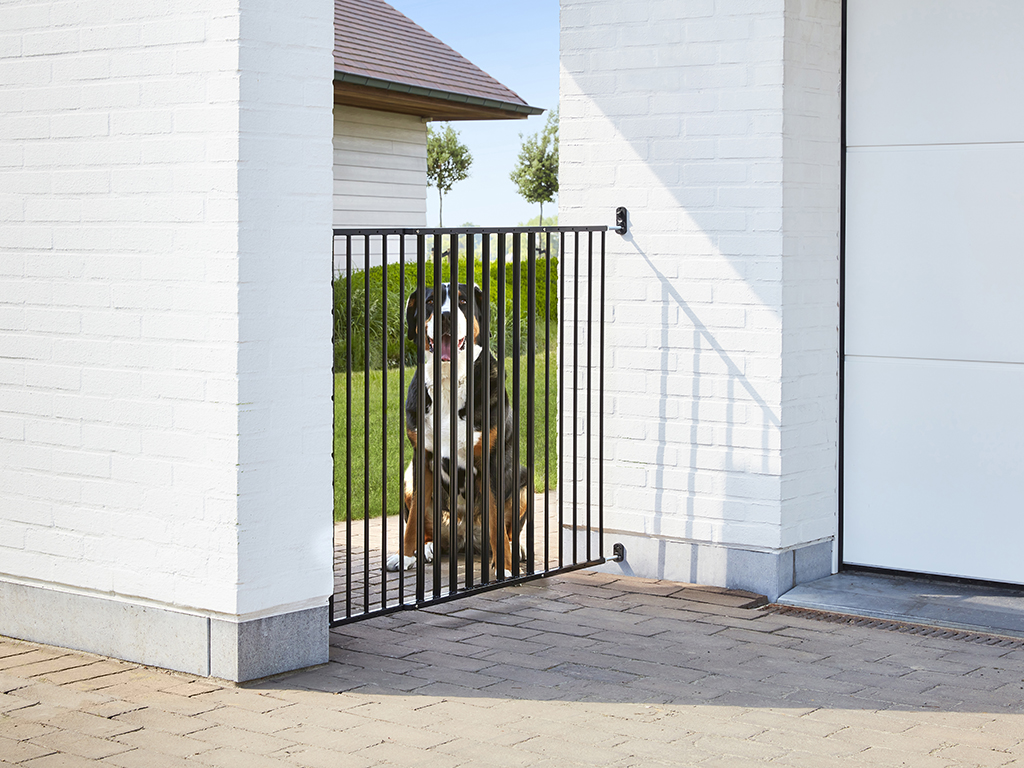
Exploring the World of Pet Gates: Types and Suitability
Pet gates are a vital addition to homes with pets, offering safety and control over pet movements. Understanding the different types of pet gates available is key to choosing one that best suits your home and pet’s needs. Here’s a detailed overview of various pet gate types, along with their ideal usage scenarios.
Freestanding Gates: Independence and Flexibility
Freestanding gates are designed to stand independently without any support from walls or doorframes. They are ideal for situations where temporary barriers are needed, or in homes where installation is not preferred. Freestanding gates work well in large open areas or as dog barriers in doorways. Their portability makes them a versatile option, though they might not offer the same level of security as mounted gates.
Pressure-Mounted Gates: Tension-based Security
Pressure-mounted gates rely on tension between walls or door frames to stay in place. They are easy to install and remove, making them ideal for renters or those who need a temporary solution. These gates are suitable for securing low-risk areas but may not be the best choice for high-risk areas like the top of stairs, as they lack the stability of hardware-mounted gates.
Hardware-Mounted Gates: Permanent and Secure
Hardware-mounted gates offer a more permanent solution. They are securely fixed to walls or doorframes, making them ideal for high-risk areas such as the top of stairs. While they require drilling for installation, their stability and security make them a preferred choice for long-term use in critical areas of the home.
Specialty Gates: Customized Solutions
Specialty gates come with unique features such as small pet doors or adjustable widths, catering to specific needs. They are ideal in scenarios where standard gates do not suffice, such as homes with both cats and dogs or spaces that require flexible gate sizes. While they offer enhanced functionality, they may come at a higher cost compared to standard gates.
Pros and Cons: Matching Gates to Household Needs and Pet Behaviors
Freestanding Gates: Their portability and ease of setup are major advantages, but they may not provide the security needed for very active pets or high-risk areas.
Pressure-Mounted Gates: Ideal for easy installation and removal without damaging walls, but not recommended for places where a more secure dog barrier is necessary.
Hardware-Mounted Gates: Offer excellent security and stability, but their permanent nature means less flexibility and the need for installation.
Specialty Gates: Provide customized solutions for specific needs, but may come with a higher price tag and complexity in usage.
Additional features of pet gates, such as gates with small doors for cats or adjustable widths, cater to specific household needs, enhancing convenience, safety, and functionality. These innovative designs can significantly improve the pet gate experience, accommodating a wide range of scenarios and pet behaviors.
In conclusion, understanding the different types of pet gates and their specific applications is crucial in selecting the right one for your home and pet. Whether you need a temporary, portable solution or a more permanent, secure barrier, there is a pet gate to suit every need and situation. Pet owners should consider their specific household requirements and their pet’s behavior when making this important decision, ensuring both safety and convenience in their choice of a pet gate.
Importance of Material and Build Quality in Ensuring Pet Safety
When it comes to the safety and well-being of our pets, the quality of materials and build of pet gates cannot be overstated. High-quality materials are crucial in ensuring the structural integrity of these gates. A gate made from strong, durable materials can reliably withstand the force exerted by active or larger pets, maintaining its shape and function over time. This aspect of durability is particularly important as it determines how well the gate will hold up against the wear and tear of everyday use.
Pet gates are typically constructed from various materials, including metal, wood, and heavy-duty plastic. When selecting a pet gate, it’s important to consider the type of material in terms of both durability and safety. Equally important is ensuring that the materials are non-toxic, as pets often come into close contact with their gates, whether by touching, licking, or biting.
To ascertain the quality and safety of pet gates, look for safety certifications or compliance with established standards. These certifications serve as indicators that the product meets high safety and quality benchmarks, ensuring that it’s safe for use around pets.
Several additional features should be considered for enhanced safety:
Secure Latches: A robust latching mechanism is essential to prevent pets from accidentally opening the gate. This feature is crucial for ensuring that the pet remains safely confined.
Smooth Edges: The gate should have smooth edges and corners to minimize the risk of injury to both pets and humans. This is especially important in households with active pets and small children.
Appropriate Bar Spacing: Gates should have bar spacing that is appropriate for the size of the pet to prevent smaller pets from squeezing through or getting stuck.
Visibility: Consider gates that allow pets to see through. This can help reduce anxiety and stress for pets by allowing them to observe their surroundings and feel less confined.
In summary, when selecting a pet gate, the safety and durability offered by its material and build quality are paramount. Pet owners should prioritize these features to ensure the long-term well-being and security of their pets. By choosing gates that are robust, non-toxic, and thoughtfully designed with safety in mind, pet owners can create a secure and comfortable environment for their furry family members.
Optimizing Pet Gate Safety Through Proper Cleaning and Maintenance
Pet gates are an essential tool for ensuring the safety and well-being of our pets. However, like any other household item, they require regular maintenance and cleaning to remain functional and safe. Here are some best practices for keeping your pet gates in top condition.
Regular cleaning of pet gates is crucial. Start by wiping down surfaces to remove dust, pet hair, and other debris. Use a damp cloth for this purpose, ensuring it’s not too wet to avoid damaging the gate material. When selecting cleaning products, opt for those that are safe for pets and suitable for the material of the gate, whether it’s metal, wood, or plastic. This not only maintains the appearance of the gate but also ensures the health and safety of your pet.
Regularly check and tighten any loose screws or hinges. This not only ensures the gate’s stability but also prevents potential accidents. Lubricating hinges or locks can also be beneficial for smoother operation, reducing the likelihood of squeaking and making the gate easier to use.
Periodically inspect the gate for signs of wear or damage, such as cracks, splinters, or weakened pressure points. This is especially important for pressure-mounted gates, as these areas are subject to the most stress and can compromise the gate’s effectiveness and safety.
Be alert to signs that your pet gate may need replacing, such as significant damage or a failure to stay secure. Consider upgrading your pet gate if your pet’s needs change, such as a puppy growing larger or alterations in your home’s layout that require a different gate style or size.
For common issues like loose panels or squeaky hinges, simple DIY repair techniques can be effective. Additionally, provide guidance on making adjustments to the gate, such as altering tension or repositioning, to ensure the best fit and functionality. Always ensure that any repairs or adjustments maintain the gate’s overall safety and stability.
In conclusion, regular maintenance, timely replacement, and the ability to perform minor repairs are crucial for the longevity and effectiveness of pet gates. Regularly investing time in checking and maintaining pet gates not only ensures the safety and comfort of your pets but also contributes to a well-organized and secure household. Encourage pet owners to be proactive in this regard, as a well-maintained pet gate is an indispensable part of a pet-friendly home.
Conclusion
In conclusion, selecting the ideal pet gate is more than just a matter of convenience; it’s a crucial step in ensuring the safety and well-being of your beloved pet while maintaining the harmony and aesthetic of your home. Throughout this guide, we’ve explored various aspects to consider—from understanding your pet’s specific needs and behaviors to choosing a gate that complements your living space.
Remember, the perfect pet gate should strike a balance between functionality and style. It should be sturdy and safe enough to contain your pet, yet easy enough for you to operate. Whether you opt for a freestanding, pressure-mounted, or hardware-mounted gate, the key is to choose one that aligns with your lifestyle and your pet’s characteristics.
Regular maintenance and a keen eye for wear and tear are essential to ensure the longevity and effectiveness of your chosen gate. But, above all, your pet’s safety and comfort should always be the top priority. The right pet gate not only creates a safe boundary for your furry friend but also gives you peace of mind, knowing they are secure and happy in their designated space.
We hope this guide has been informative and helpful in your quest to find the ideal pet gate. Your pet’s safety is a significant responsibility, and by taking the time to choose the right gate, you’re contributing significantly to their well-being. We’d love to hear from you about your experiences and choices in pet gates. Feel free to share your stories and insights, as they might help fellow pet owners make informed decisions for their furry family members.
Happy pet-proofing, and may your pet enjoy their safe and loving space for years to come!

